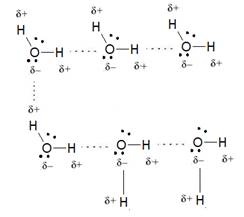
Concept explainers
Interpretation:
The effect of intermolecular attractions on the boiling and freezing point of the substance (water and methane) needs to be explained.
Concept introduction:
The strength of intermolecular forces present between the molecules influences the properties of the substance like boiling point, freezing point, etc. If the strength of the intermolecular forces is strong, then it results in higher boiling point and low vapor pressure of the liquid.
Explanation of Solution
The structure of water,

Methane is a non-polar molecule whereas water is a polar molecule. The force of attraction between polar molecules are greater than those of non-polar molecule so, methane being non-polar will possess less attraction between methane molecules but water molecules possess polar
Due to presence of an oxygen atom in water, the formation of intermolecular hydrogen bonding takes place in which O atom of one molecule of water is bonded to H atom of another molecule of water. The hydrogen bonding in

Hence, the water molecule has higher boiling and freezing point than methane.
Chapter 21 Solutions
Chemistry: Matter and Change
Additional Science Textbook Solutions
General Chemistry: Principles and Modern Applications (11th Edition)
Chemistry: The Central Science (14th Edition)
Organic Chemistry (9th Edition)
Chemistry: Structure and Properties (2nd Edition)
Essential Organic Chemistry (3rd Edition)
 ChemistryChemistryISBN:9781305957404Author:Steven S. Zumdahl, Susan A. Zumdahl, Donald J. DeCostePublisher:Cengage Learning
ChemistryChemistryISBN:9781305957404Author:Steven S. Zumdahl, Susan A. Zumdahl, Donald J. DeCostePublisher:Cengage Learning ChemistryChemistryISBN:9781259911156Author:Raymond Chang Dr., Jason Overby ProfessorPublisher:McGraw-Hill Education
ChemistryChemistryISBN:9781259911156Author:Raymond Chang Dr., Jason Overby ProfessorPublisher:McGraw-Hill Education Principles of Instrumental AnalysisChemistryISBN:9781305577213Author:Douglas A. Skoog, F. James Holler, Stanley R. CrouchPublisher:Cengage Learning
Principles of Instrumental AnalysisChemistryISBN:9781305577213Author:Douglas A. Skoog, F. James Holler, Stanley R. CrouchPublisher:Cengage Learning Organic ChemistryChemistryISBN:9780078021558Author:Janice Gorzynski Smith Dr.Publisher:McGraw-Hill Education
Organic ChemistryChemistryISBN:9780078021558Author:Janice Gorzynski Smith Dr.Publisher:McGraw-Hill Education Chemistry: Principles and ReactionsChemistryISBN:9781305079373Author:William L. Masterton, Cecile N. HurleyPublisher:Cengage Learning
Chemistry: Principles and ReactionsChemistryISBN:9781305079373Author:William L. Masterton, Cecile N. HurleyPublisher:Cengage Learning Elementary Principles of Chemical Processes, Bind...ChemistryISBN:9781118431221Author:Richard M. Felder, Ronald W. Rousseau, Lisa G. BullardPublisher:WILEY
Elementary Principles of Chemical Processes, Bind...ChemistryISBN:9781118431221Author:Richard M. Felder, Ronald W. Rousseau, Lisa G. BullardPublisher:WILEY





